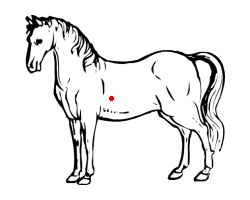|
By Jerry Tardif
Many riders are told that it's good to be over their horse's center of gravity when jumping, and that's definitely true.
But in fact, you want to be there when riding in general, especially at the faster gaits.
It's easier for you to sit stably there and it's easier for your horse, just as it's easier for us humans to carry large loads in backpacks on our back when it's over our center of gravity.
This all well and good, but for many, the real question is, "Where is my horse's center of gravity?"
The actual location of your horse's center of gravity (COG) varies slightly with the conformation of the horse.
In general, it usually falls just a few inches aft of the horse's front shoulder and about a third of the way up from the bottom of the stomach.
That spot will often fall under your saddle's girth or cinch strap.
HOWEVER, while that is the general area of the COG, a horse with a long spine will have his COG further back.
A horse with a long neck and light butt will have his COG further forward.
And the horse's body being thinner (e.g. like a Thoroughbred) or much rounder (a la a Quarter Horse) can make a difference as to how high or low the COG falls on his body.
So, while we can identify the general area, the actual COG of any specific horse will vary with his conformation.
There is a way for you to get a pretty close estimate of where a horse's specific COG is located.
If you want to find the specific COG of your horse, here's what you do:
- Have a friend hold your horse in an open area with his head up while standing squarely;
- Stand on the side of your horse about 15 - 20 feet away and take a photo of him;

The photo of your horse should look something like this.
- Print the photo so the length of the horse is about 8 or 10 inches long.
If you can't make a print that large, print the largest size you can and enlarge the image with one or more passes through a copy machine.
Don't worry about image quality because we only need your horse's outline (his silhouette);
- This solution will work even better if you can transfer the silhouette to some construction paper or light cardboard.
When at the desired size, trace the image with a pen using some pressure to emboss the silhouette onto the construction paper or cardboard.
Make several of these if you can (at least two);
- Cut out your horse's shape with a pair of good scissors, knife, razor blade, or some other sharp cutting tool.
Do as good a job as you can, but don't worry if it's not perfect;
- Take a sharp pin and push it through the cutout about where the girth or cinch usually falls behind his shoulder and about 1/3 of the way up his stomach.
The red spot on the image above shows a typical COG and is a good starting point to get you close; and
- Now, slightly spin the cutout and see where it stops (head up, head down, head at 45° head level, etc.)
If it stops at different positions each time, you've found the Center of Gravity.
If it keeps stopping in the same place, then the part at the bottom is heavier and you need to pull the pin out and move it down a little toward the part that keeps stopping at the bottom.
A few passes should let you get pretty close to the COG and the extra cutout will come in handy if you need many passes and pin holes to find the COG.
Looking down from the top of your horse, the COG will obviously be in the center of his body, so all you need to do is set your saddle so the center of your seat is over the spot you found on the cutout.
Depending on your horse's conformation, it is possible that his COG is so forward that you can't actually sit over it without being on his withers or over his shoulders with your legs — don't try to do that.
Instead, sit as close as you can to the spot, but still behind his withers and shoulders.
This is rare and a problem with only a few horses that have unusually long, heavy necks, big chests, and small butts.
For most horses, you'll be able to sit over the COG.
Some riders are sensitive enough to find their horse's COG just from the feel of movement when riding.
Sitting over the COG is the location which moves the rider the least and disturbs the horse's balance the least — it's easier for both.
And as we all learn, it's even more important when jumping.
Becoming sensitive enough to find a horse's COG just "by feel" is a wonderful ability to develop, if you can.
With it, you'll be able to easily find and sit over the COG of any horse you ride.
Besides being an avid trail rider, Jerry Tardif is a technology consultant and a horse and nature photographer in SE Connecticut — see his work at: www.jerrytardif.com.
He is also co-founder and President of QueryHorse.
Back to Article Index
|